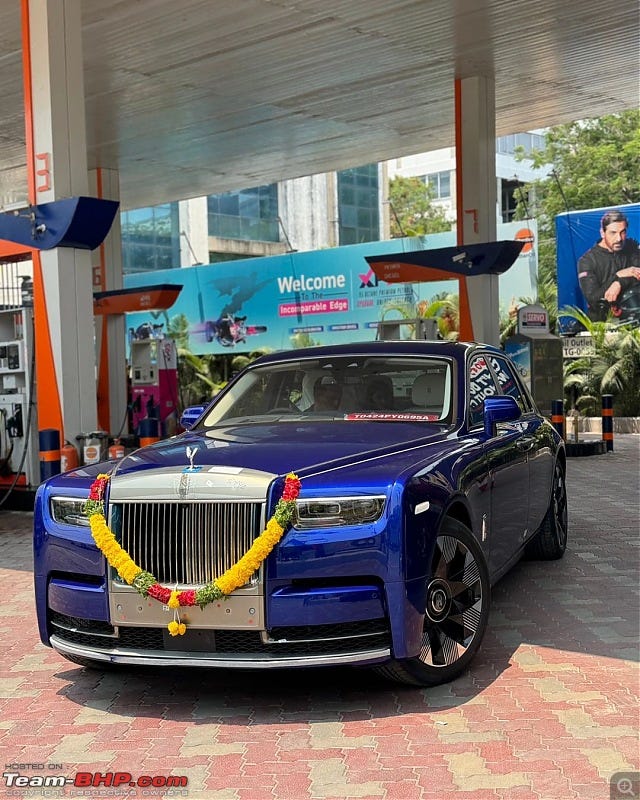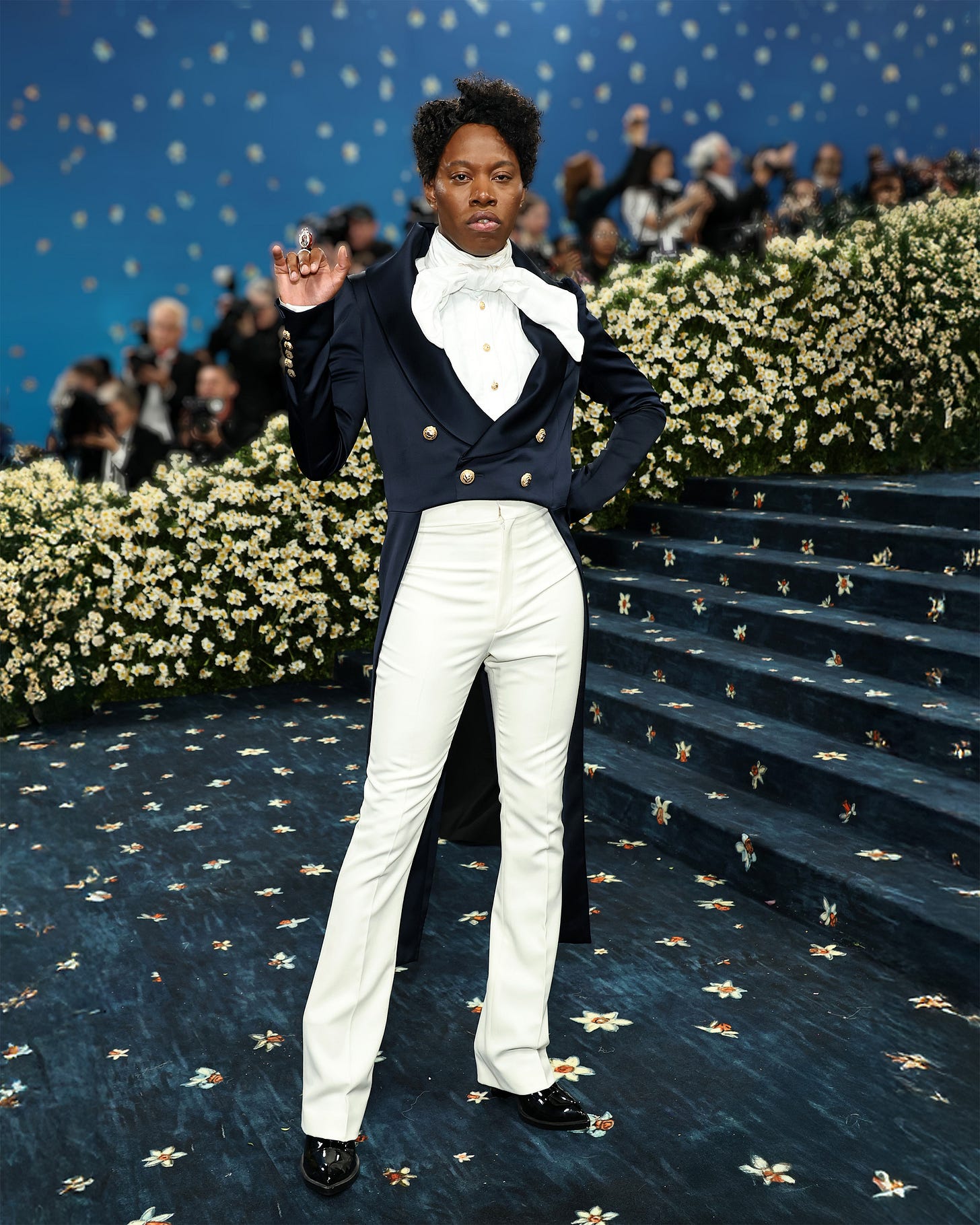More whisky and Rolls Royces in Hyderabad
Some good tariffs news for the luxury business, Trump wants a gold furnished Air Force One previously owned by the Qataris, and the Met Gala in this week's round-up
In this week’s Dark Luxury news round-up:
Good news for UK companies exporting expensive whisky and high-end cars to India
The best of the Met Gala analysis on Substack
The dupes apocalypse is here, and it’s hitting US sales of Temu and Shein (and Big Tech’s advertising revenue)
Diageo and Rolls Royce could benefit from UK-India trade deal
Some good news for the UK’s whisky and luxury automotive industries this week, as the UK and India signed a trade deal after three years of talks. That includes an immediate halving of Indian tariffs on UK-made whisky and gin from 150 per cent to 75 per cent, and a reduction in tariffs on “high-end” UK car exports from 100 per cent to just 10 per cent under a quota system.

India imports (and presumably drinks) more Scotch whisky by volume than any other country, although the US, France, Singapore and Taiwan are larger importers by value. What’s not immediately clear is if or by how much Diageo, Pernod Ricard and other Scotch whisky makers will pass on the price reduction to Indian consumers. Local, state-by-state Indian tariffs also complicate the situation. But this tariff cut is a clear opportunity for the industry to expand in India, says Henry Jeffreys, who has written on his Substack about the Indian love of Scotch whisky, and who I spoke during a quick phone interview today.
It’s astonishing that despite those 150 per cent tariffs, India became the largest export market for Scotch whisky in 2023. Prices there are extortionate compared to the US or the UK. Before today’s reduction in tariffs, “a bottle of Black Label will cost around $30 in America but at least $75 in India”, wrote Jeffreys in his Substack, with a top-of-the-line bottle of Blue Label costing around $500 (£374). You can get the same bottle for $183 in California or about £140 in the UK.
Blue Label has long been a prominent example of conspicuous consumption in India, says Jeffreys. Indian families show off by placing a bottle of Blue Label on every table at weddings. He raises an idea that will be familiar to Dark Luxury readers, that any potential drop in the price of such a conspicuously consumed product could in fact destroy some of its cachet. Of course, the drinks companies don’t have to pass on all of the tariff reductions to the consumer, and Jeffreys doubts they will.
“The whole point of Blue Label, for example, is to be seen to be spending. It does matter what the price is, but it doesn’t matter that it’s very expensive, because that’s kind of the point. So if it’s 25 per cent less expensive, does that mean people are going to buy more? It’s very hard to know”, he said.
Jeffreys says there may be potential to drive sales in India of rare or limited edition Scotch whisky, which is currently going through an extended sales slump with a 34 per cent decrease in volume for the £1,000 to £10,000 sales bracket last year. “I suppose [there’s] some huge potential, isn’t there? [Single malt whisky brand] Macallan are sort of stagnating. A lot of their releases aren’t capturing people’s attention”, he said. “The Chinese gift market is sort of finished. The Americans with their tariffs [might say] we haven’t got any money over here, so I think a lot of them will be eyeing India up”, he said. (Read more on Jeffreys’ Substack, Drinking Culture)
As for the car industry, Autocar writes that the big winner of the tariff cuts appears to be Jaguar Land Rover, followed by Aston Martin, Bentley and Rolls-Royce. Rolls Royce sells around 60-70 cars a year in India, and considering the price of the cars, if the tariff reductions are passed on fully to customers we could be seeing a lot more Phantoms on the streets of Hyderabad. (Autocar)

Met Gala watch
There've been so many brilliant news stories and Substack posts about the Met Gala that we thought we’d round-up some of the best here.
Amy Odell breaks down the power plays of Anna Wintour, who she says offers a “fascinating view on culture as dictated by a single authority”, adding, “At the Met Gala, the people who are invited and therefore ‘in’ are simply decided upon by one woman, Anna Wintour”. (BackRow)
The Wall Street Journal’s interview with Usher is (inadvertently?) revealing as Ray A. Smith explains how despite paying $350,000 for a table, he wasn’t allowed to choose who sat with him. “He said that he had wanted a prominent director, a few artists and a ‘major, major’ athlete at his table, but they were turned down. ‘Yeah, I was bummed,’ he said.” Yeah?! Usher, U Got it Bad. (WSJ)
Former Men’s Vogue editor Bonnie Morrison wrote a nuanced take on what it felt like watching an event and exhibition when just a few years ago it was almost unthinkable that such a thing would be possible. She writes, “The dream that continues to be frustratingly unfulfilled is the one where Black faces are not just (temporarily) adorning the walls and vitrines – or guarding them – but streaming through the room, tonight and forever after”. (Is It Okay?)
Ayan Artan similarly summed up the power and politics dynamics of the night, asking, “Why do black artists have to die in order to get the respect they deserve? We are radiant and worth fussing over even as we live. Let us make a habit of remembering that”. (rentfree)
Tiffanie Darke says the tension created by the Met Gala is a good thing because it might help lead us to change. “‘Would the looks that graced the steps at the Met mirror the arguably parasitic relationship between high fashion and Black culture?’ asked the Business of Fashion. But it seems fears of cultural appropriation were misplaced”, she wrote. (It’s Not Sustainable)
Louis Pisano’s post echoed Alfred and I’s sentiment about playwright Jeremy O. Harris’s choice of outfit. “He wore Balmain, channeling Black jockey legend James Winkfield. We love a history lesson in a tux”, he wrote. The best, or at least the most appropriate and interesting outfits on the night, were ones that most effectively understood the source material of the exhibition, I thought. I’m disappointed no-one wore an outfit inspired by WEB Du Bois’s excellent and extremely political infographics, though. (Discoursted)

Few mentions of Diddy
As a reminder, here’s our take from the weekend about the Diddy-shaped hole in this year’s Met Gala. Diddy’s trial is on-going, where jurors are being selected. Rather extraordinarily, a juror who worked for the streaming service that made the HBO documentary The Fall of Diddy was initially part of the jury selection, although they were later excused.
Inside the gold furnished Boeing 747 that Trump wants to replace Air Force One
Frustrated with Boeing’s delays in making a new version of the 747 which gets the designation Air Force One when he’s on board, President Trump wants to buy a plane once owned by the Qatari government which comes with gold walls and furnishings. Formerly listed for $400 million, the VVIP 747-8 is near the top of the private aircraft food chain. It has an interior designed by Paris-based Alberto Pinto, known for being one of the small group of aircraft interior designers who create “flying mini-mansions”. Just don’t tell Trump about the even bigger private Airbus A380 commissioned by Saudi’s Prince Alwaleed Bin Talal al-Saud, although this reportedly never flew in its private configuration. (Business Jet Traveler and New York Post)
Tesla UK sales fall off a cliff
Tesla’s sales have continued to fall off a cliff following Elon Musk’s slow-motion political car crash, with registrations plummeting to just 512 cars in April 2025, down more than 60 per cent on the same period last year. Sales of China’s all-electric brand BYD have leaped 654 per cent. Polestar’s sales have almost doubled too. Jaguar’s temporary absence from the market may be somewhat distorting the figures as it undergoes a widely-mocked rebrand. (SMMT)
The dupes apocalypse is here
Dark Luxury previously covered the prospect of the “dupes apocalypse”, in which the closing of a tax loophole could cause a wipeout of the widespread shipping of fake luxury products from China to the US and Europe. We also mentioned the possible knock-on effects on Big Tech, which relies to a huge extent on advertising from cheap fast fashion and dupe makers. That advertising bonanza now appears to be coming to an end, in line with the closing of the loophole by President Trump. (The New York Times) Temu and Shein US sales have also dropped by an average of about 20 per cent in the last week of May. (Business of Fashion)
The Sun here, promoting (and apparently profiting via affiliate links) a £10 Matalan knock-off of a £610 Hermès sandal. We already know what Hermès’s CEO is likely to think of such offers. (The Sun)
Harrods: ‘the old corner shop’
Omar Fayed, the late Mohamed Al Fayed’s son, a lifelong environmentalist with an interesting track record of executive positions including investments in companies that promote human space colonisation, a scientific sailing ship, “living walls”, and a documentary about LSD, reportedly wanted to turn Harrods into a “flagship of green retail”. “Everybody, including my dad, thought I was mad”, he said in a Times interview. What could have been. (The Times)
Tanning at 40,000 feet
Another one to add to our list of “crazy things people do on private jets”. Tanning expert James Read recounts being asked to tan a client aboard a private jet on their way to appear at the Met Gala. “I waited patiently while they had their nails and facial done mid-flight, and right before we landed, I applied the tan in fine layers to make sure it would be even and red-carpet ready immediately”, he told The Cut. (via Emily Sundberg’s Feed Me)
Too many Lambos
Younger ultra-high-net-worth clients are reportedly addicted to buying extremely expensive luxury products, says the founder of a Zurich-based treatment centre. Jan Gerber has coined a phrase to describe it, “opulomania”, which is already appearing in Google Trends. We can’t judge the effectiveness of the recovery centre’s techniques (“have you considered shopping at Oxfam?”) but whoever is doing their PR clearly deserves a raise judging by their extensive press clippings page. Treatment prices, perhaps ironically, start at 95,000 Swiss Francs (£86,577). Per week. (The Times)
Super-rich snap up Starlink
Super-rich people are increasingly working from their superyachts thanks to the availability of Starlink, which is now installed on between 80 and 90 per cent of new yachts according to data from sailing rallies. Prices are significantly higher on superyachts for the Starlink Maritime service, which costs £1,745 a month for 2TB of data, compared to £75 a month for a standard residential option. (The Times)
Starlink’s maritime services, which bring internet access to vast swathes of the ocean for things like oil rigs, cargo ships and cruise ships, could potentially be a big driver in the number of launches of low-earth orbit satellites. Researchers have recently discovered that this dramatic increase in launches could potentially be destroying parts of the upper atmosphere and the ozone layer. (Bloomberg News)
Fashion PR firm Lucien Pagès, who brought Jacquemus to the attention of the world, is merging with AIPR. (Vogue Business)
Did you find this newsletter useful or interesting? Please forward it to a friend or colleague, or share your thoughts with us on Bluesky or on Instagram.





